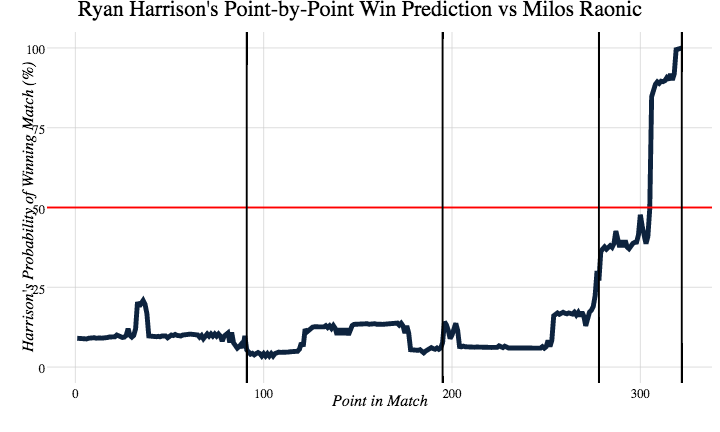On a day of surprising results, American Ryan Harrison sprang perhaps the biggest upset of all with his 6-7(4) 7-5 7-5 6-1 win over fifth seed Milos Raonic. But how did world No.220 get the win? Stephanie Kovalchik from Tennis Australia’s Game Insight Group (GIG) analyses the keys to Harrison’s stunning win.
To read the full version of this article, visit on-the-t.com.
Harrison might have been the crowd favourite going into the match, but he was also the massive underdog. FiveThirtyEight’s US Open model gave Harrison just a 9% chance of pulling off the win.
Given those odds, I was curious to see how Harrison turned the match in his favour. Below is a graph plotting the American’s point-by-point win expectation, which updates Harrison’s pre-match odds given the current score. You can see that, even when going into the fourth set and having 2 sets under his belt, Harrison was never a sure bet. In fact, it wasn’t until breaking Raonic in the fourth game of the fourth set that Harrison finally took the win advantage.

Why are these predictions so much against Harrison, even when he had more sets on the board than Raonic?
There are a few reasons. The predictions assume that each player has a constant chance of winning a point on serve. The serve predictions are based on the expected win chance of 91% for Raonic and a 50% gap between Harrison’s percentage of points won on serve and his points won on return, as this is how he has performed on hard courts against top 10 players this year. The predictions don’t consider player injuries (which clearly was an issue with Raonic) and don’t update the serve ability based on the way things are trending during the match. Instead, they tell us what we would expect the outcome to be from the current score if both players were playing to their expected abilities.
16 February 2017
In the first part of our series analysing the similarities and differences between men's ... More
1 March 2016
At one end of the facial serenity spectrum you have Roger Federer, a picture of unhurried ... More
18 January 2016
Shot charts are critical in understanding a player’s on court behaviour. They have becom... More
24 May 2016
With all eyes on the red clay of Roland Garros, there's plenty that club players can do to... More